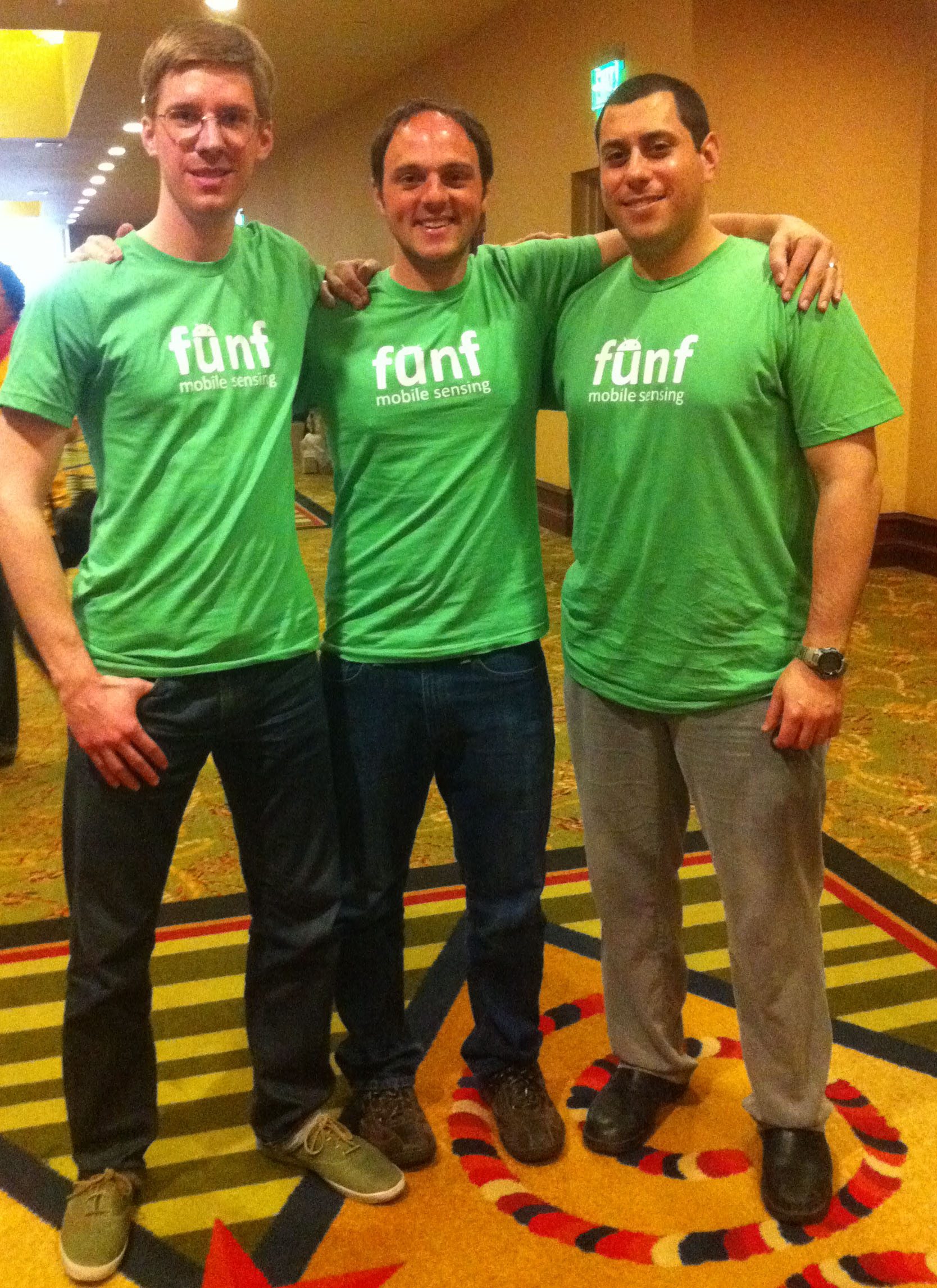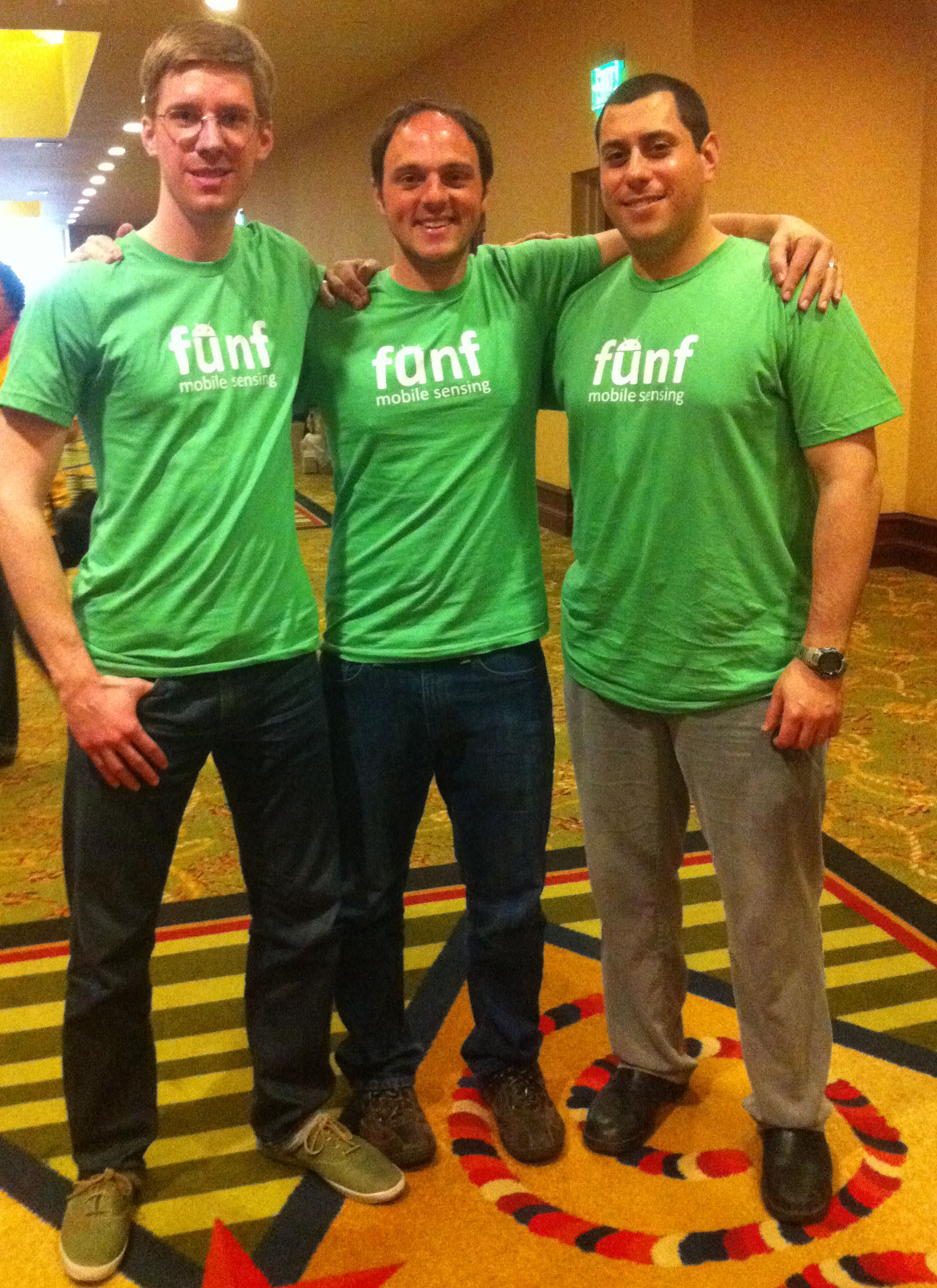
Funf wins SXSW Accelerator Competition in News Related Technologies track
A visualization of Funf. Design: Cody Sumter
Last night, Funf, an open sensing framework, won the 2012 SXSW Accelerator Competition for the News Related Technology track.
Funf, which launched in October, explores how mobile phones can be used as sensor platforms to track the location, movement, app activity and extended networks of its users and communities.
With Funf, users can contribute anonymously to creating data sets for themselves and their communities. For example, during a disaster, Funf could use the data from the sensing networks in people’s cellphones to create real-time maps of which roads are clear or blocked, where there is a cell phone outage and where people are trapped. Funf also collects data about the surrounding environment, including levels of light, pressure and temperature.
Researchers also may be able to predict small changes in individuals’ behavior – like changes in sleeping and waking patterns and communications – that could have important implications for predicting diseases.
Collected data can be measured by the Funf framework and configured in a variety of ways, including in data visualizations, notifications and other applications.
Knight Foundation, a sponsor of the Accelerator Competition, sat down to interview key members of the Funf team – Nadav Aharony, Alan Gardner and Cody Sumter – to learn what winning the competition meant for them and what’s next for the project.
Knight Foundation: What does winning the competition mean for you? Nadav Aharony: Winning reinforces the support of the community for this project. It demonstrates that there is a real interest in supporting it. It will make us rethink our own plans regarding the project’s future sustainability. We need to make sure the project expands and we want to make sure it is useful and livable beyond its current form. What do you want people to know about Funf? NA: It’s important to know that it is still in its early development – in alpha stages. It isn’t going to be a perfect system. We intentionally give the freedom of configuration to the user and hope that they’ll tell us what works and what doesn’t. It’s important for us to get feedback from both developers and end-users so we can figure out how to improve it. We’re already seeing that kind of feedback and it’s great. How has the SXSW experience been for you? How have people reacted to Funf? Alan Gardner: It’s been really very positive. At a fundamental level, people are interested in collecting and analyzing their own data. But it goes beyond people just thinking about the data in terms of their own lives. People get intrigued by the bigger possibilities and implications it may have for researchers, communities, journalists and society. NA: Our core philosophy is that we care about the end-user. That’s why we give them ownership of their data. But we also care about using the data for the public good, not necessarily to make money off of it. People have responded really well. How important for you is it that this project is open source? NA: It’s extremely important. When we publicly launched the Funf in a box service (which helps users create their own mobile sensing app with no programming required), within a few hours someone found a security hole in it and published it in our forum. Immediately we were able to address it. That’s the power of the open source community and something that would not have happened if we were closed source. What’s been the most exciting or surprising thing about working on this project? AG: I didn’t understand what you could learn by having aggregate data from lots of people all of whom are interacting with each other. There is a lot of rich sensor data that allows you to infer things you wouldn’t necessarily expect. For example, a lot of times people’s behavior is predictable, but by looking at subtle changes in an individual or communities behavior, you may be able identify larger changes in behavior. Cody Sumter: For me, it’s exciting when you start being able to layer different data sets on top of each other. Sure you can have raw accelerometer data, but if you can build on top of that more data about the user – eg if they walking or running, you’re going to get more useful information. You can use bluetooth data to see if two friends are talking to each other, you can track who you’re physically spending time with. It’s cool because you’re using data sets to determine a real face-to-face social network, which is different from Facebook or other networks. What’s next for Funf? NA: Our goal is to grow and stabilize a community of developers around us. We want to make this a real non-profit foundation, one that is able to foster further development. We want to connect the technical people who are interested in doing machine learning with the end-users, the journalists and psychologists who are eager to use it for their research. That’s the advantage we see in having this built on a common platform, much like the Internet itself, it can customized by different users depending on their needs and interests. We see amazing excitement around us and it really motivates us. The following video, by Nadav Aharony, illustrates how data collected by Fun can be used as a visualization. A “heat map” – it visualizes the movement patterns of two separate Funf users, as gathered from their data every day over a month. The red end of the spectrum designates highly frequented areas while colors at the blue end designate only occasionally frequented areas.
Funf was selected from three finalists, paired down from an original group of eight semi-finalists. Finalists were judged on their project’s creativity, its potential, core team members and functionality. Ellen Miller, co-founder and executive director of The Sunlight Foundation, Tim O’Reilly, founder and CEO of O’Reilly Media and Richard MacManus, founder and editor-in-chief of ReadWriteWeb, judged the final round of the competition.

(l to r) Cody Sumter, Alan Gardner, Nadav Aharony
Over 650 companies entered this year’s competition. A complete list of this year’s News Related Technologies finalists is available online. This year marks the fourth of the SXSW Accelerator Competition, which seeks to discover the most innovative online technologies in the categories of news, health, social media, entertainment and more. It is the second consecutive year Knight has sponsored the News Related Technologies track.
Recent Content
-
Journalismarticle ·
-
Journalismarticle ·
-
Journalismarticle ·


